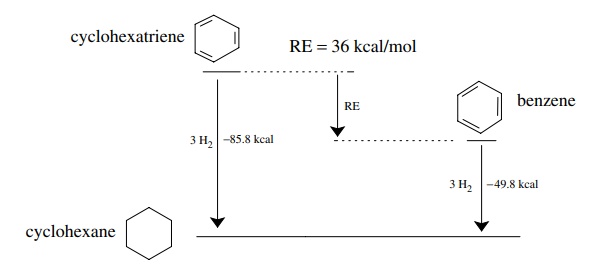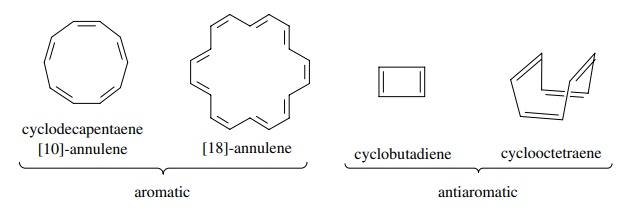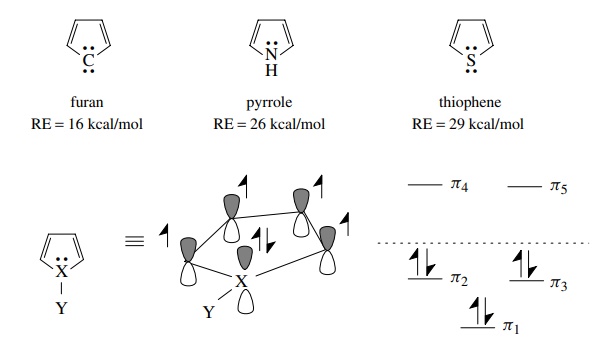Aromaticity
| Home | | Organic Chemistry |Chapter: Organic Chemistry : Functional Groups and Chemical Bonding
A special type of orbital interaction occurs when a conjugated π system is in a ring. The π system of benzene is a classic example of this behavior. In benzene, the carbons of the six-membered ring are sp2 hybridized, and so each has a singly filled 2p orbital to interact with the others of the conjugated system.
AROMATICITY
A
special type of orbital interaction occurs when a conjugated π system is in a ring. The π system of benzene is a classic example
of this behavior. In benzene, the carbons of the six-membered ring are sp2
hybridized, and so each has a singly filled 2p orbital to interact with the
others of the conjugated system. The six 2p orbitals interact, giving rise to
six new MOs. Three are bonding MOs and three are antibonding MOs. Because of
the symmetry properties of the six-membered ring, the six MOs are distributed
energetically, as shown below. The six available π electrons completely fill
the bonding levels, leading to an enhanced stability of the π system, which is termed aromatic
stabilization or aromaticity.

This
“extra” stability of benzene and other aromatic compounds was a well-known phenomenon.
In fact, aromaticity was first described as chemical stability (unreactivity)
toward reagents that normally attack double bonds and π systems. Moreover, reagents which did attack the aromatic ring
gave substitution products in which the aromatic ring was retained; the same
reagents usually give addition products with typical double bonds and
conjugated π systems.
Since
stability refers to energy level, aromaticity was later defined as the energy
difference between an aromatic π
system and a model π system in which
there is no aromatic stabilization. The aromatic stabilization of benzene was
taken as the difference between the heat of hydrogenation of benzene (ΔH hyd = −49.8 kcal/mol) and the heat of hydrogenation of the hypothetical
molecule cyclohexatriene (ΔHhyd = −85.8 kcal/mol), which has three
noninteracting double bonds in a six-membered ring. The heat of hydrogenation
of cyclohexatriene was estimated as being three times the heat of hydrogenation
of cyclohexene. Since both give cyclohexane upon hydrogenation, a difference in
the heats of hydrogenation must be due to a difference in the energies of the
starting mate-rials. This difference amounts to 36 kcal/mol (it is termed the
RE of benzene), and it corresponds to the extra stability of benzene due to
aromatic stabiliza-tion. The same approach can be used to estimate the
resonance energy of other aromatic molecules.
A
physical distinction between benzene and the hypothetical model compound is
that benzene has equal bond lengths and bond angles and is planar, whereas the
hypothetical model would have localized bonds and unequal bond lengths (double

Aromaticity
was found to be a general property of many (but not all) cyclic, conjugated π systems. Moreover, it was found that
aromaticity in molecules can be predicted by Huckel’s rule. The structural
requirements implicit in Huckel’s rule are that there be 4n + 2 (n is an integer) π electrons in a cyclic, conjugated π system. Obviously benzene, which has six π electrons (4n + 2, n = 1) in a conju-gated
π system, is aromatic. However,
Huckel’s rule predicts that molecules such as cyclodecapentaene 4n + 2 = 10 (n = 2) and
[18]-annulene 4n + 2 = 18 (n = 4) should be aromatic, have equal bond lengths,
and be planar — and they are.
A
further manifestation of aromaticity is the presence of ring current in
aro-matic molecules. When aromatic compounds are placed in the magnetic field
of an NMR instrument, a ring current is induced in the π system. The ring current results in an induced magnetic field
which causes the protons attached to the aromatic ring to absorb nearly 2 ppm
downfield from simple olefinic protons. Aromatic character can thus be detected
by a downfield shift of protons attached to the aromatic ring.
In
contrast to aromatic molecules which have 4n
+ 2 π electrons, cyclobuta-diene and
cyclooctatetraene do not have 4n + 2 π electrons and are not aromatic. In fact, these molecules, which
contain 4n π electrons (n is an integer), are less stable than the planar model
compounds and are termed antiaromatic. Both of these molecules adopt shapes
that minimize interactions of the π orbitals.

Cyclobutadiene
is an antiaromatic 4n = 4 (n = 1) system, and it is quite unstable and
can only be observed at very low temperatures. Although it must be planar
(accounting for its instability), it distorts to a rectangular geometry with
unequal bond lengths to minimize π
-bond interactions. Planar cyclooctatetraene would be an antiaromatic 4n = 8 (n = 2) system, and thus it adopts a boat
shape so that the π bonds are
orthogonal and cannot interact!
Huckel’s
rule is more than an operational way to identify aromatic molecules. Its
origins are in MO theory and its applicability is general, regardless of ring
size or charge. In terms of Huckel’s rule, the requirement for aromatic
stabilization is that there is a cyclic system with all atoms having a p
orbital available for interaction. The array of MOs produced from this
interaction is populated by the total number of electrons that are present in
the interacting p orbitals. If that number of electrons is 4n + 2, then the molecule will have
aromatic stabilization. It turns out that the above requirements lead to a
situation where the bonding MOs are completely filled, the nonbonding orbitals
are either completely filled or completely empty, and antibonding levels are
unfilled.
As
seen above in the MO description of benzene, there are three bonding MOs that
are filled by the six electrons of the π
system. In another example, the tropylium ion is known to be aromatic. The
interaction of seven 2p orbitals leads to an MO array with three bonding MOs
and four antibonding MOs. The six electrons fill the bonding MOs and give an
aromatic system, irrespective of the fact that, to do so, one of the seven
interacting p orbitals must be unfilled, leading to a net positive charge on
the delocalized aromatic ion.

It
is also clear why cyclooctatetraene is not aromatic. The interaction of eight
contiguous 2p AOs in a planar ring gives rise to an MO array which has three
occupied bonding MOs and two nonbonding MOs which are degenerate and thus
singly occupied. Since this is an unstable bonding situation, the molecule
distorts to the shape of a boat so that interactions are avoided and four isolated
π bonds can form. It is clear that
either by removing two electrons (8 → 6 π electrons) or by adding two electrons (8 → 10 π electrons), one could reach an aromatic system. It turns out that
cyclooctatetraene is easily reduced by the addition of two electrons which fill
the nonbonding MOs and give a planar, aromatic dianion.

Examples
of simple aromatic molecules and ions which have been studied are shown below.

Other
elements can also participate in the formation of aromatic species. Furan,
pyrrole, and thiophene are all aromatic molecules. This is due to the fact that
if the heteroatom is sp2 hybridized, then a doubly occupied p
orbital interacts with the carbon 2p orbitals to give an MO array which
contains six π electrons and is
aromatic. Note that in the development of the MO diagram for these systems the
identity of the heteroatom is not important. It is only important in
determining the magnitude of the aromatic stabilization.

The
added stability of an aromatic system is a significant energetic feature of
molecules. Reactions which occur with the formation of an aromatic system are
generally facile, while reactions in which an aromatic system is disrupted are
generally very difficult. Thus aromaticity can dramatically influence the
reactivity of compounds and should be kept in mind.
Related Topics
